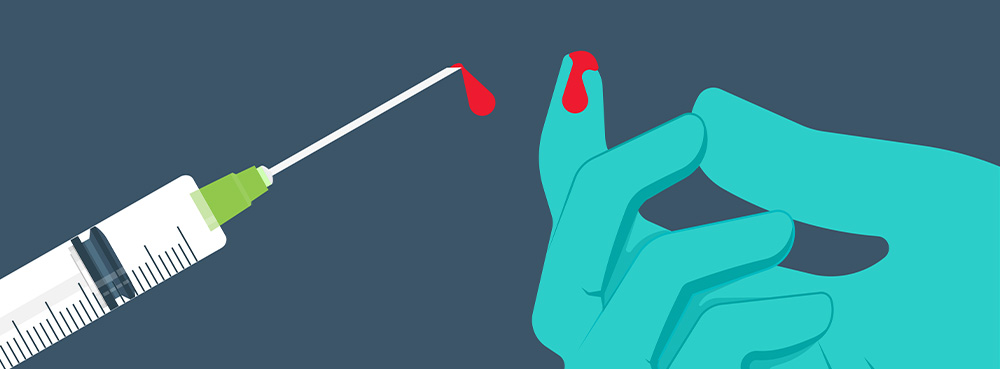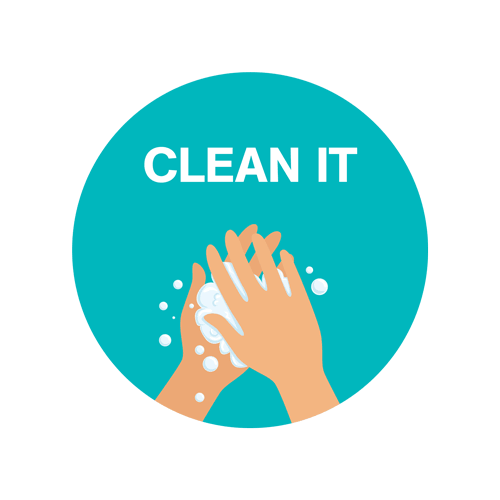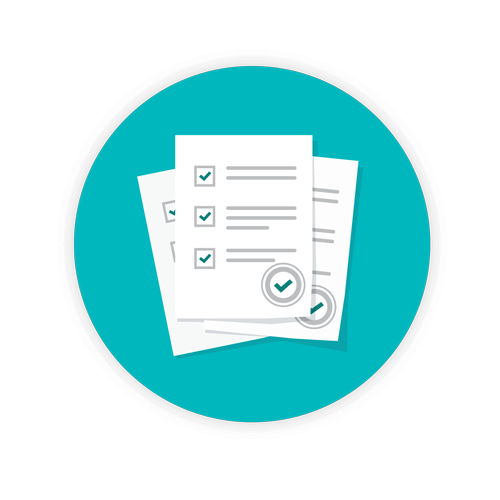So You’ve Just Been Stuck with A Sharp. Now What?

Healthcare workers work with a wide variety of sharps during the course of treating patients. This means that needlestick and sharps injuries can and will happen. But when the worst case scenario happens, panic can be prevented by knowing the correct course of action. Learn the critical steps to take immediately following a sharps accident to help minimise risk and remain compliant with safety protocols. If you are a healthcare professional in Canada, this is information that’s worth routinely reviewing to make certain you’re well-versed on proper sharps accident procedure.
TOPICS WE WILL COVER:
1 / Steps to Take After a Sharps Injury
2 / What Are the Risks Associated with a Sharps Injury?
3 / Preventing Sharps Injuries from Reoccurring
4 / Sharp Safety Improvements are Easy to Implement with the Right Plan and Approach
Steps To Take After a Sharps Injury
As soon as a sharps injury occurs, it is crucial to take certain steps to treat the injury and reduce the chances of infection. Following this, there should be a long-term exposure management response to protect the well-being of the exposed individuals.
Immediate Management of a Sharps Injury

When a sharps injury occurs, it’s important to work quickly to treat the injury. Here are steps to take in line with those recommended by the Canadian Centre for Occupational Health and Safety and the University of Oxford.
- For small wounds and punctures occurring from sharps, it is important to never apply compression. Instead, allow the wound to bleed freely under running water if possible.
- Wash the wound with soap and water for at least 10 minutes using liberal amounts of soap.
- Be thorough in cleaning the wound, but do not scrub, squeeze, or suck on the wound while attempting to cleanse it.
- Gently dry the wound and dress it with a waterproof plaster or bandage.
- Flush exposed eyes, nose, or mouth with a saline solution, if possible. If saline isn’t easily accessible, tap water will do.
-
Report the incident following facility guidelines as applicable. The exposed individual should also report to an emergency healthcare facility as soon as possible for further evaluation and treatment.
Post Exposure Response
Following the immediate response to the emergency, more long-term management will be necessary as well. The exposed individual will need further evaluation and treatment to determine and mitigate the risks associated with the injury. The exact procedures will vary depending upon the circumstances of the injury, but the “Guidelines for the Management of Exposures to Blood and Body Fluids” published by the Saskatchewan Ministry of Health can give an idea of what the typical procedures to follow will be. This includes the following steps:
- Perform a risk assessment.
- Collect information from the exposed individual concerning the details of the exposure incident.
- Interview the source patient to determine the most appropriate care for the exposed individual if they grant consent.
- Test parties for illnesses including HIV, hepatitis B, and hepatitis C.
- Determine if post-exposure prophylaxis is necessary.
-
Follow-up with further monitoring, testing, and treatment as necessary.
Notably, in many cases, facilities will need to report exposure cases to the local Ministry of Health and Workers’ Compensation Board. This will often be included in an agency’s existing incident reporting protocols.
What Are the Risks Associated with a Sharps Injury?
Sharps injuries pose an obvious risk of transmitting infectious diseases, including but not limited to: Human Immunodeficiency Virus (HIV), hepatitis B, and hepatitis C.
Needle punctures pose an additional risk of injecting hazardous drugs or infectious fluids into the injured party. However, any sharps injury can open cuts that allow for bodily fluid exchange. The smallest amount of bodily fluid exposure can lead to the transmission of dangerous blood-borne pathogens and other maladies. Exposure to infected blood poses an extreme risk of infection. In fact, The Ontario Hospital Association/Ontario Medical Association (2016) estimates that there is a 6-30% chance that an exposed person will be infected after a workplace injury from a needle contaminated with hepatitis B. There is about a 0.3% chance of infection in scenarios with HIV contamination and about a 1.8% chance of infection in situations with hepatitis C.
Preventing Sharps Injuries from Reoccurring
In the wake of a sharps injury, administrators may ask, “How can our medical facility prevent sharps accidents like this from occurring?” Advance planning stops injuries before they happen, and there are a number of steps staff can take to avoid unsafe situations.
Revising Staff Policies
First, experts advise workers not to recap needles as a means of preventing injury. It’s much more effective to reduce handling time by disposing of sharps immediately in a point-of-use container designed for sharps placed near common waste generation sites. When staff are able to immediately eliminate sharps from the environment, there is less opportunity for accidents to occur. However, never place sharps in a non-specialized disposal container, as this can increase the risks during final disposal. Also, never allow a sharps container to overflow. Sharpsmart by Daniels Health checks off all of these best practices for sharps disposal. We’ll dig into the details of this container system more below, but first, there are other policy steps which should also always be in place. These include:
a point-of-use container designed for sharps placed near common waste generation sites. When staff are able to immediately eliminate sharps from the environment, there is less opportunity for accidents to occur. However, never place sharps in a non-specialized disposal container, as this can increase the risks during final disposal. Also, never allow a sharps container to overflow. Sharpsmart by Daniels Health checks off all of these best practices for sharps disposal. We’ll dig into the details of this container system more below, but first, there are other policy steps which should also always be in place. These include:
- Whenever staff members have an open wound or lesion, they should always have a dry dressing in place while in the workplace to avoid creating unnecessary exposure risks.
- Workers who may be exposed to sharps and bodily fluids should always wear appropriate PPE for the tasks they perform, including eye, nose, and mouth protection.
-
Staff should stay up to date on all vaccinations, especially Hepatitis B and Tetanus. As a whole, facilities should train and educate the team on infection mitigation and sharp safety.
The Centre for Communicable Diseases and Infection Control at the Public Health Agency of Canada (PHAC) published guidelines titled “Routine Practices and Additional Precautions for Preventing the Transmission of Infection in Healthcare Settings.” Canadian Centre for Occupational Health and Safety establishes that injury prevention concerning sharps is a part of healthcare workers’ “routine practices.” The establishment of a sharps injury prevention program, including training and education for staff who work with sharps and anyone who may be exposed, is a requirement.
PHAC promotes the use of safety-engineered devices such as protected needle devices or needle-free systems with self-sealing ports and syringes, and some states and jurisdictions require it. The administration must always take into account the safety of staff and patients when planning the implementation of these devices.
Introducing a Safe Disposal Plan
The most important thing is to start with a plan for safe sharps disposal. Utilising proper waste disposal containers can be the single largest factor in reducing sharps risks. Sharpsmart by Daniels Health is a system of sharps disposal containers designed to reduce sharps injuries and promote safer staff habits through its ease of use.
Peer-reviewed studies have shown switching to Sharpsmart correlates with a reduction in needle stick injuries by up to 87%. Daniels makes these bins with overflow prevention features, penetration and needle-proof materials, and hands-free operability. Mobile and mounting options allow the bins to be at the point of waste generation, no matter where in the facility it may be. The leak and spill-proof design, as well as the no-touch design of these bins, mitigates contamination and infection risks. The containers are reusable and Daniels’ state-of-the-art robotic washing and sanitising process for cleaning bins ensures their safety.
Sharp Safety Improvements are Easy to Implement with the Right Plan and Approach
Responding to a critical situation like a needlestick injury promptly and appropriately is a test of a facility’s safety planning. It is possible to reduce the frequency of sharps injuries and improve outcomes by taking smart steps.
Having a plan for safe sharps disposal, including relying on an intelligently designed waste system like Sharpsmart, following relevant compliance standards, educating staff on how to prevent and respond to sharps injury, and having a clear reaction plan to any incident can help minimise the risk of sharps injuries, helping to prevent them before they occur. With small, proactive steps, your healthcare facility can create the optimal work environment for staff that places the safety of employees and patients as a top priority. Want to learn more ways to address medical waste concerns in a smart and pragmatic manner? Reach out to Daniels. Our experienced team can guide you through the process of streamlining your practices for optimal safety and efficiency.
